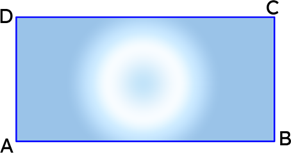Rectangles are a ubiquitous and fundamental type of quadrilateral, commonly encountered in our everyday lives. From architectural designs to everyday objects, rectangles are a prevalent geometric shape that plays a crucial role in various fields. This blog post aims to explore the key properties of rectangles, delving into their defining characteristics, mathematical relationships, and practical applications. By understanding the core attributes of rectangles, we can gain valuable insights that can be applied in diverse contexts, from engineering and construction to art and design. Whether you're a student, a professional, or simply someone curious about the world of geometry, this exploration of rectangles will provide a solid foundation for understanding this important shape.
What is a Rectangle?
A rectangle is a type of quadrilateral, or four-sided polygon, characterized by the following key features:
- Four sides: A rectangle has four straight sides.
- Parallel and equal opposite sides: The opposite sides of a rectangle are parallel and equal in length.
- Right angles: All four angles of a rectangle are right angles, measuring 90 degrees each.

Rectangles are a fundamental geometric shape with numerous practical applications in various fields, from architecture and engineering to art and design. Understanding the defining properties of rectangles is crucial for working with and understanding this ubiquitous shape.
Properties of Rectangle
A rectangle is a four-sided plane figure. A rectangle is a four-sided polygon with opposite sides that are parallel and equal in length. It's a quadrilateral with all four angles being right angles or equivalent to 90 degrees. A rectangle is a sort of parallelogram in which all of the angles are equal. A square is defined as a rectangle with four equal sides.
- A rectangle is a quadrilateral.
- The opposing sides are parallel and equal in size
- The internal angles are all 90 degrees.
- Rectangle is known as a square, if the two diagonals bisect each other at right angles.
- 360 degrees is equal to the total of all interior angles.
- The diagonals cut each other in half.
- Perimeter of a rectangle with lengths of sides k and m is 2k+2m units
- The diameter of a rectangle's circumcircle is its diagonal.
- Both diagonals are equal in length.
- If a and b are the sides of a rectangle, then d= √a2 + b2
- xi is the length of each diagonal. At different angles, the diagonals intersect each other. One angle is acute, while the other is obtuse.
- When the rectangle is rotated along the line connecting the midpoints of the longer parallel sides, it becomes a cylinder. The height of the cylinder is equivalent to the width of a rectangle in this situation. Furthermore, the diameter of the cylinder is equal to the length of a rectangle
- The area of a rectangle with side lengths a and b is ab sin 90 = ab square units.
- When the rectangle is rotated along the line connecting the midpoints of the shorter parallel sides, it becomes a cylinder. The height of the cylinder is equal to the length of a rectangle in this situation. Similarly, the width of a rectangle is equal to the diameter of a cylinder.
Formulas Related to Rectangles
Rectangles are defined by their length and breadth (or width), and two key formulas are used to calculate their area and perimeter.
Area: The area of a rectangle is the measure of the total space enclosed within its four sides. The formula for calculating the area of a rectangle is:
Area = Length x Breadth
Perimeter: The perimeter of a rectangle is the total distance around its four sides. The formula for calculating the perimeter of a rectangle is:
Perimeter = 2 (Length + Breadth)
For example, if a rectangle has a length of 5 units and a breadth of 3 units, the area would be 15 square units (5 x 3), and the perimeter would be 16 units (2 x [5 + 3]). These formulas are essential for understanding and working with rectangles in various applications, from construction and engineering to art and design.
Frequently Asked Questions
The key properties of a rectangle are:
- All four angles are 90 degrees (right angles)
- Opposite sides are equal in length and parallel
- Diagonals are equal in length and bisect each other
All rectangles share these properties:
- Four right angles (90 degrees)
- Opposite sides are parallel and equal in length
- Diagonals are equal in length
The 5 main characteristics of a rectangle are:
- Four right angles (90 degrees)
- Opposite sides are parallel
- Opposite sides are equal in length
- Diagonals are equal in length
- Diagonals bisect each other
The general properties of all shapes include:
- They have a defined number of sides and angles
- They occupy a specific area or region in space
- They can be classified into different categories (e.g. polygons, circles, etc.)
The two key properties of a rectangle in Class 8 are:
- Opposite sides are equal and parallel
- All angles are right angles (90 degrees)